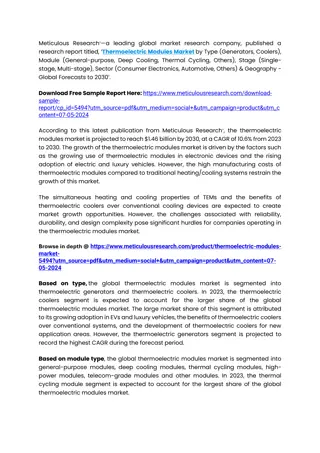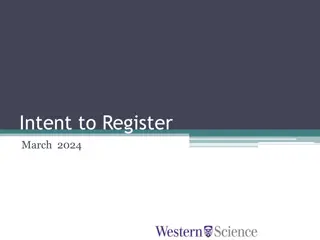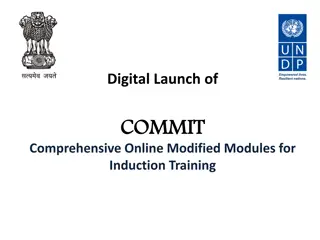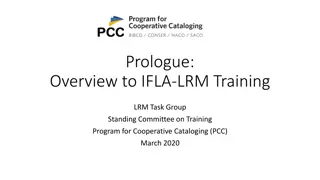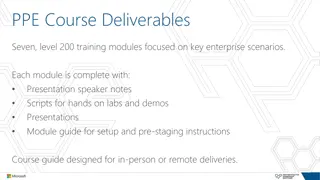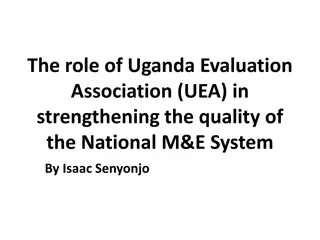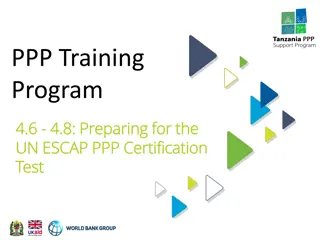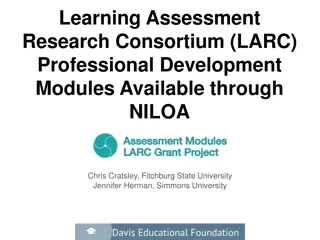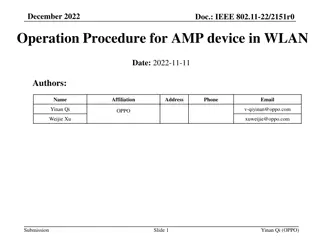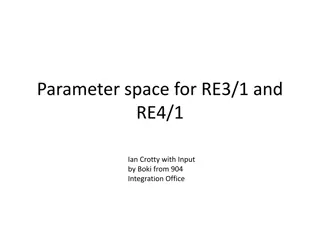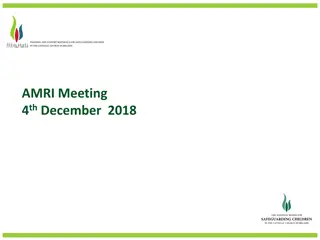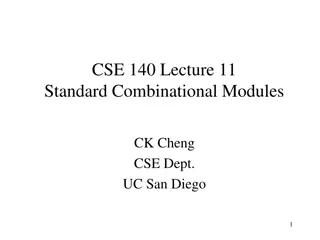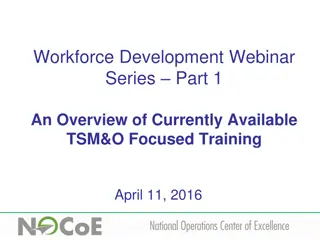Comprehensive Overview of AMP Training and Development Modules
Explore in-depth training modules on risk factors, controls, accept/reject testing, audit objectives, reporting, and control activities. Dive into understanding business processes, control activities, and notes on risk factors vs. controls. Learn about accept-reject sampling for tests of details and its core components for efficient decision-making in audits.
Download Presentation

Please find below an Image/Link to download the presentation.
The content on the website is provided AS IS for your information and personal use only. It may not be sold, licensed, or shared on other websites without obtaining consent from the author.If you encounter any issues during the download, it is possible that the publisher has removed the file from their server.
You are allowed to download the files provided on this website for personal or commercial use, subject to the condition that they are used lawfully. All files are the property of their respective owners.
The content on the website is provided AS IS for your information and personal use only. It may not be sold, licensed, or shared on other websites without obtaining consent from the author.
E N D
Presentation Transcript
AMP Training Learning and Development AMP Refresher Training: Phase one
Training outline 1. Risk factors and direct / indirect controls 2. Accept/ Reject Testing 3. Audit of predetermined objectives: effect of usefulness testing on reliability testing 4. Audit of predetermined objectives: Evaluating and concluding 5. Audit of predetermined objectives: Reporting 6. Audit Report
AMP Training Learning and Development ModuleOne Risk factors and direct/ indirect controls
Understanding a business process What is done How it is done For all relevant assertions Initiation Reporting Remember to corroborate inquiries through observation and inspection
Control activities that are relevant to the audit: Relate to significant risks (i.e. require special audit consideration) Relate to risks for which substantive procedures alone do not provide sufficient appropriate audit evidence Relevant to the audit (mitigate risks of material misstatement of financial statements)
Notes on risk factors vs controls (Direct/Indirect)
AMP Training Learning and Development ModuleTwo Accept/ Reject Testing
See ch 10.1 Annexure D Accept-reject
Accept-reject sampling for tests of details A means to more efficiently arrive at a conclusion about whether a population is free from material misstatement or not. Gather evidence to decide whether to accept or reject a population Can only be applied under strict conditions May eliminate the need to apply the normal approach for tests of details Concerned with whether or not an item is misstated, yes or no Projection N/A May test specific and follow with accept reject on remaining
Accept-reject sampling for tests of details Core components: Auditor s logical and valid expectation that the population is not misstated For discussion: 1. What would be the basis for this expectation in scenario 1 and scenario 2?
Accept-reject sampling for tests of details Core components: Auditor s logical and valid expectation that the population is not misstated For discussion: 2. What happens if the results of the tests of controls confirm reliance on the operating effectiveness of controls at the desired level of assurance that had been planned?
Accept-reject sampling for tests of details Core components: Auditor s logical and valid expectation that the population is not misstated For discussion: 3. What happens if the results of the tests of controls confirm reliance on the operating effectiveness of controls at a lower level of assurance than had been planned?
Accept-reject sampling for tests of details Core components: Auditor s logical and valid expectation that the population is not misstated For discussion: 4. Can the auditor stop testing the accept-reject sample when a misstatement is identified?
Accept-reject sampling for tests of details Core components: Auditor s logical and valid expectation that the population is not misstated For discussion: 5. Scenario 1: Can the auditor include the items tested as part of the accept reject sample in the normal tests of details sample, if the results of the accept-reject testing does not confirm the auditor s expectation that the population is not misstated?
Accept-reject sampling for tests of details
AMP Training Learning and Development ModuleThree Audit of predetermined objectives: effect of usefulness testing on reliability testing
Rule - Measurability Measurability is assessed based on the two misstatement conditions Well defined Verifiable Must be predetermined and consistently applied by auditee throughout the year
Rule - Measurability Core components: 1. Source/collection of data 2. Method of calculation 3.Type of output Well defined Sub-conditions: Indicator as a whole Clear unambiguous definition Defined for consistent data collection Verifiable Sub-conditions: each target related to an indicator SPECIFIC MEASURABLE TIMEBOUND Must be predetermined and consistently applied by auditee throughout the year
Rule - Measurability Core components: 1. Source/collection of data 2. Method of calculation 3.Type of output For discussion: Well defined Verifiable 1. Are TIDs required for an indicator to be well-defined? 2. What does specific imply? 3. Is time-bound implied due to inclusion in an ANNUAL performance plan 4. What if no documented processes and policies? Must be predetermined and consistently applied by auditee throughout the year
Rule - Measurability Well defined For indicator (and its targets): Possible to verify the processes and systems that produce the indicator Verifiable For discussion: What is the link with existence of systems, if any? Must be predetermined and consistently applied by auditee throughout the year
Impact of measurability misstatements on testing of reliability If an indicator is not measurable (i.e. not well-defined and verifiable) the results may be so severe it prevents the auditor to perform further work on reliability Apply the assessment criteria If the criteria 1 or 2 applicable = 100% limitation misstatement Other situations Perform reliability testing Criterion 1 Criterion 2 If all conditions are met No further work If all conditions are met No further work
Impact of measurability misstatements Criterion 1 If all conditions are met - No further work No documentation and information available on: i. the performance measurement processes and systems, including TIDs/data definitions; and ii. documented policies and SOPs; and iii. management is unable to explain any of the core componentsto understand how the indicator is measured and explanations can t be corroborated.
Impact of measurability misstatements Criterion 1 If all conditions are met No further work No documentation and information available on the following: i. the performance measurement processes and systems, including technical indicator descriptions (TIDs) or data definitions; and ii. documented policies and standard operating procedures (SOPs); and iii. in the absence of documented processes, management is unable to explain any of the core elements that are necessary to understand how the indicator is measured. Core components Source or collection of data (including source documentation required) Method of calculation, or Type of output
Impact of measurability misstatements Criterion 2 If all conditions are met No further work No/limited indication of any of the core components in the available documentation and information: (i) No/limited indication of any of the core components in the performance measurement processes and systems, including TIDs/data definitions; and (ii) No/limited indication in any documented policies and SOPs; and (iii) Management unable to explain how the indicator is measured and explanations can t be corroborated
Impact on testing of reliability If criteria 1 or 2 applicable Auditor is unable to test reliability = 100% limitation misstatement Guidance on limitations imposed by management is applicable Refer limitation scenario 3 Respond accordingly
Exercise Refer attendees to the SToD - AoPO - CMRPD DFF from the training sessions
AMP Training ModuleFour Audit of predetermined objectives: Evaluating and concluding
Accumulation of misstatements NB In relation to each performance target For each assertion tested
Accumulation of misstatements Indicator Target C M R P&D Reliability VAC Indicator 1 Target 1.1 Yes No No No No Indicator 2 Target 2.1 No Yes No No Yes Target 2.2 No No No No No Indicator 3 Target 3.1 No No No No Yes
Evaluating usefulness misstatements NB Final uncorrected misstatements are evaluated to determine whether or not the misstatements are material Any misstatement for material performance indicators/measures Any misstatement for non- material indicators/measures = NOT MATERIAL = MATERIAL MISSTATEMENT
Evaluation of reliability misstatements relating to material targets MOR 10% quantitatively material and therefore material to the programme/objective/development priority as a whole
Evaluation of reliability misstatements relating to material targets MOR < 10% Qualitative evaluation of the misstatement evaluate whether the misstatement is material, individually or when considered together with other misstatements nature, cause and circumstances qualitative considerations Chapter 15 para 65
Material misstatement relating to reliability All targets to a material indicator are regarded as a material target If material target is materially misstated, indicator is materially misstated If only 1 material indicator is materially misstated the subject matter is materially misstated http://clipartzebraz.com/cliparts/warning-clip-art/cliparti1_warning-clip-art_05.jpg
Opinion/ Conclusion Focus on the usefulness and the reliability aspects of the individual performance indicators and their targets AND their interaction, interrelationship and combined effect on the subject matter as a whole Message being communicated for the selected programme/objective/ development priority)
Non-material performance indicators Not evaluated individually The combined effect of the results of misstatements pertaining to the individual targets and its performance measures/indicators are considered in determining the conclusion on the subject matter as a whole
Unmodified auditors opinion If there are no uncorrected misstatements or if the effects or possible effects of uncorrected misstatements are not material it provides a basis for an unmodified auditor s opinion.
Auditors judgement regarding the pervasiveness of the effects or possible effects on the reported performance information for the programme/objective/development priority concerned Nature of matter giving rise to the modification Material but not pervasive Material and pervasive Qualified opinion 1 Adverse opinion 3 Reported performance information is materially misstated Qualified opinion 2 Disclaimer of opinion 4 Inability to obtain sufficient appropriate audit evidence
Material and pervasive Considerable professional judgement All relevant quantitative and qualitative factors about the misstatements that have been identified and the auditor s understanding of the entity and its environment It is about the effect of it all on the message being communicated for the selected programme/objective/development priority.
Material and pervasive Qualitative factors to be considered Chapter 18.2
Evaluation of uncorrected misstatements WP
AMP Training Learning and Development ModuleFive Audit of predetermined objectives: Reporting
Reporting Updated reporting guidance Management report template technical update 10 of 2017 Chapter 3 of reporting guide technical update 11 of 2017
Reporting (cont.) The structure, layout and guidance revised based on changes to the methodology: Expressing one opinion/conclusion on usefulness and reliability per subject matter Refer management report template Reporting of material misstatements per indicator Refer chapter 3, section B Reporting of phased-in misstatement conditions for usefulness in the Annexure of the management report Refer chapter 3, section D par 40-49
Reporting (cont.) Reporting on limitations imposed by management based on revised guidance (chapter 9.2 section J) Limitation scenario 1 Refer to the management report template for guidance on the statement to be reported in the management and auditor s report. Refer chapter 3, paragraph 51 if procedures were performed on measurability and relevance Limitation scenario 2 Refer to the management report template for guidance on reporting a disclaimer of opinion/conclusion in the management report Refer to chapter 3 paragraph 30 and 31 for examples of the Basis for the disclaimer of opinion/conclusion paragraphs
Reporting per indicator example paragraph Updated examples of standard wording that can be used for reporting Refer chapter 3, section C1 Combined findings per indicator - par .34 Material misstatements on measurability resulting in limitation on reliability par. 35 Illustrative examples Refer chapter 3 section C2 Worst case scenario par. 36 Indicators with multiple targets par. 37 Exact same finding for multiple indicators par. 38
Reporting per indicator combined example paragraph (par 34) Indicator X The reason for the variance between the planned target of X (include details) and the reported achievement of Y (include details) was not reported in the annual performance report, as required by the Annual report guide for [national and provincial departments or schedule 3A and 3C public entities]. In addition, the reported achievement for target X (include details of planned target) was misstated as the evidence provided indicated Y (include audited value) and not Z (include reported value) as reported.
AMP Training Learning and Development ModuleSix Audit report
Background Improved auditor s report - to increase the value of our work in enabling our stakeholders to exercise accountability, oversight and good governance IAASB released its new and revised Auditor Reporting standards to enhance the informational value and relevance of the auditor s report Revision of our audit methodology introduced changes to how we audit and report on the annual performance report of auditees
Background Revision of our audit methodology introduced changes to how we audit and report on the annual performance report of auditees Main aim to provide simple, clear and relevant information in the auditor s report to enable understanding and oversight
Background Changes do not change the underlying work effort Changes focus on increasing transparency Improved auditor communication More insightful and relevant




